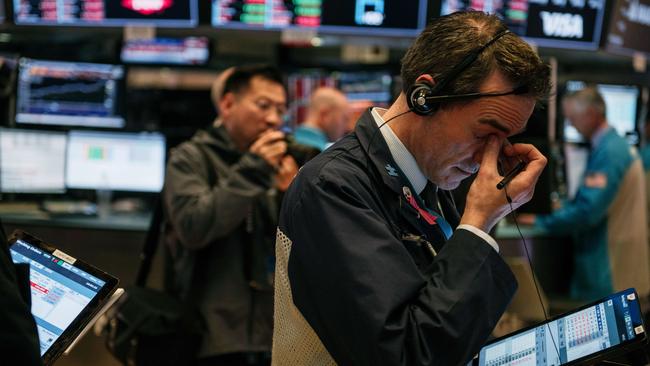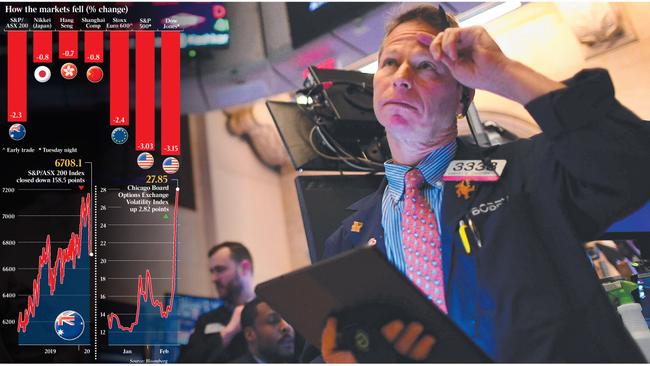Market sinking in a sea of red
Australia’s sharemarket has suffered its biggest three-day fall in 4½ years as the coronavirus spread hammers the growth outlook.

Australia’s sharemarket has suffered its biggest three-day fall in 4½ years as the spread of coronavirus hammers the economic growth outlook, driving global sharemarkets lower.
After hitting a record high of 7197.2 last Thursday, the local market has now lost 6.3 per cent or $136bn of its value, mirroring a similar fall in the US, as investors adjust to the prospect of a deeper and longer downturn in the global economy as the virus spreads beyond China.
On Wednesday, its worst day in more than six months, the benchmark S&P/ASX 200 share index fell 158.5 points, or 2.3 per cent, to 6708 after the S&P 500 dived more than 3 per cent on Wall Street for a second day running.
Among the heavy losses, CSL fell 4.1 per cent, Magellan dived 7.2 per cent and Macquarie lost 2.4 per cent, South32 tumbled 6.6 per cent and Woodside fell 3 per cent. Newcrest fell 2.9 per cent after a pullback in gold prices.
“I’d say despite that drop that there is still probably more to come before we see the bottom in this sell-off,” said Richard Coppleson, head of institutional sales and trading at Bell Potter.
The Australian market has erased almost all of a 7.7 per cent rise this year and the ASX 200 has fallen below its 200-day moving average for the first time in over 12 months.
The intensification of this week’s market sell-off came as COVID-19 virus cases surged in South Korea and Italy, while also spreading in the Middle East and Europe, and in the US the Centers for Disease Control and Preventions said the virus was expected to spread in America.
China’s reported cases of the virus rose by 401 to 78,064, although 29,745 patients have been discharged. More concerning for markets this week has been the spread of the virus elsewhere, particularly in South Korea, where reported cases of the virus rose 23-fold to 1146 in the past week.

Regional sharemarkets were in the red with the Shanghai Composite down 0.9 per cent, the Nikkei 225 down 0.8 per cent, the Hang Seng down 0.9 per cent, South Korea’s Kospi down 1.3 per cent, Singapore’s FTSE Straits Times index down 1 per cent and the SE THAI index down 2.9 per cent.
In early European trade on Wednesday night, the Stoxx Europe 600 index fell 2.4 per cent, with the German DAX down 2.4 per cent and London’s FTSE 100 Index down 1.5 per cent.
The futures market was pointing to a fall at the open of the S&P 500 Index of 0.6 per cent.
However, demand for safe havens including spot gold, US Treasury bonds and the Japanese yen appeared to ease slightly after recent strong gains on the back of the coronavirus outbreak.
Spot gold dipped as much as 3.8 per cent from a seven-year high of $US1689.31, the 10-year Treasury yield bounced about 7 basis points after hitting a new record low of 1.3055 per cent, and the Japanese yen rose slightly against the US dollar.
But the Australian dollar continued to slide alongside further weakness in industrial commodities. The dollar fell 0.5 per cent to a fresh 11-year low of US65.70c.
Brent crude oil was down 0.5 per cent to $US54.67 a barrel in Asian trading, having fallen 7 per cent in the past four days, and London Metal Exchange copper was down 0.7 per cent to $US5645 a tonne.
“There is a lot of cash on the sidelines,” said Mr Coppleson.
“But analysts are worried about smaller companies that have exposures and will be looking through their balance sheets to ensure they can survive if things were to get worse and cash flows dry up.
“If that happens, then possibly a few smaller companies may need to raise cash at big discounts, like what we saw in the global financial crisis.
“The bigger ones will be okay.”
JPMorgan was the latest forecaster to lower its China economic forecasts again, forecasting 3.3 per cent year-on-year GDP growth in the March quarter, down from a previous forecast of 4.6 per cent.
Haibin Zhu, the chief China economist at JPMorgan, predicted a deeper contraction in economic activity including industrial production, retail sales, fixed assets investment and trade in February, followed by a stronger rebound in March and the June quarter. But while arguing that the coronavirus situation in China seemed to have improved, especially outside of Hubei, Mr Zhu said uncertainty about the epidemic outlook “remains high”, particularly in regard to work resumption in China and contagion outside of the country. “High-frequency tracking indicators suggest that the pace of factory reopening is slow,” he said.
“Attributing factors include shortage in labour, disruption in transportation, disruption in supply chain, strict criteria for factory reopening and factory owners’ concerns.”
But he predicted that China would refrain from rolling out large demand-side stimulus.
“Policy support will focus on rescue measures, stimulus will be targeted (via) infrastructure, public health and high-end manufacturing, and continue the policy stance before the virus outbreak.”
He expected China’s fiscal deficit to rise by 1 percentage point of GDP in 2020, and anticipated that the People’s Bank of China would deliver another two reserve ratio requirement cuts, while also cutting its medium-term lending facility and loan prime rates by 10 basis points. Housing and carmaking policies were expected to be adjusted, albeit not as much as the large moves in 2015.
But despite the improved situation in China, Mr Zhu noted that infection data had started to show daily increases outside China, especially in South Korea, and warned that in mainland China — outside Hubei — a gradual normalisation in production and population flow ran “the risk of a new wave of contagion”.
“Hence, the uncertainty in the COVID-19 epidemic outlook remains significant.”
At the same time, Hong Kong’s financial secretary Paul Chan has warned the Chinese outpost was likely to post a record deficit in its next full year budget.
In his budget speech, Mr Chan said the spread of coronavirus had dealt a severe hit to the economy and sentiment, and the near-term impact on the economy could be greater than SARS.
Mr Chan also unveiled $HK120bn ($23.4bn) of counter-cyclical measures, including a cash handout of $HK10,000 for each permanent resident over 18 years of age, taking some fiscal responsibility.
Japanese Prime Minister Shinzo Abe called for major sporting and cultural events to be called off, postponed or scaled down over the next two weeks, saying the move was crucial in preventing the domestic spread of the coronavirus.
Saxo Markets warned in a note to clients that sharp falls in global markets had been driven by a misselling of risk, and are set to persist. Australia strategist Eleanor Creagh described the recent turn as flipping “very suddenly from outright complacency to all out panic”, with the effects exacerbated by the heady valuations in the market.




To join the conversation, please log in. Don't have an account? Register
Join the conversation, you are commenting as Logout